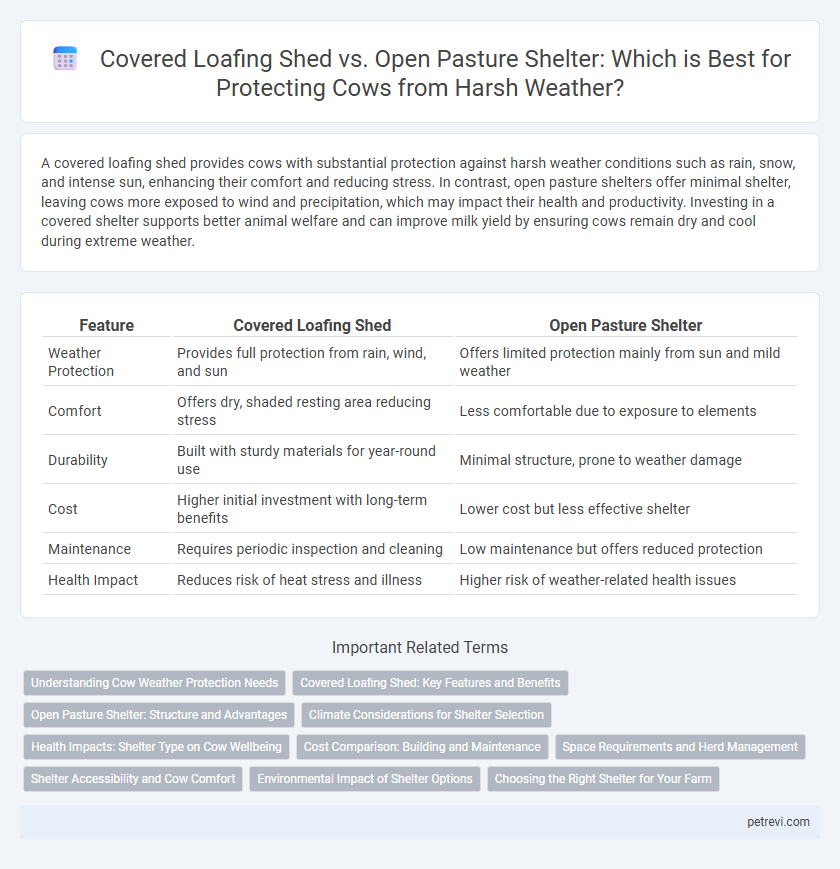A covered loafing shed provides cows with substantial protection against harsh weather conditions such as rain, snow, and intense sun, enhancing their comfort and reducing stress. In contrast, open pasture shelters offer minimal shelter, leaving cows more exposed to wind and precipitation, which may impact their health and productivity. Investing in a covered shelter supports better animal welfare and can improve milk yield by ensuring cows remain dry and cool during extreme weather.
Table of Comparison
| Feature | Covered Loafing Shed | Open Pasture Shelter |
|---|---|---|
| Weather Protection | Provides full protection from rain, wind, and sun | Offers limited protection mainly from sun and mild weather |
| Comfort | Offers dry, shaded resting area reducing stress | Less comfortable due to exposure to elements |
| Durability | Built with sturdy materials for year-round use | Minimal structure, prone to weather damage |
| Cost | Higher initial investment with long-term benefits | Lower cost but less effective shelter |
| Maintenance | Requires periodic inspection and cleaning | Low maintenance but offers reduced protection |
| Health Impact | Reduces risk of heat stress and illness | Higher risk of weather-related health issues |
Understanding Cow Weather Protection Needs
Covered loafing sheds provide cows with controlled shelter from rain, wind, and extreme temperatures, significantly reducing stress and improving health outcomes. Open pasture shelters offer minimal protection, exposing cows to fluctuating weather conditions that can lead to increased vulnerability to illness and discomfort. Proper cow weather protection prioritizes consistent shelter to maintain thermal comfort, reduce energy expenditure, and support optimal milk production.
Covered Loafing Shed: Key Features and Benefits
Covered loafing sheds provide essential weather protection for cows by offering shelter from rain, snow, wind, and excessive sun, ensuring better animal comfort and health. These structures feature durable roofs, open sides for ventilation, and ample space for cows to move freely, reducing stress and promoting natural behaviors. Properly designed loafing sheds contribute to improved milk production and overall herd welfare by minimizing exposure to harsh weather conditions.
Open Pasture Shelter: Structure and Advantages
Open pasture shelters for cows typically feature sturdy, weather-resistant frames with open sides to ensure ample ventilation and natural airflow. These structures allow cows to access shade and protection from rain while promoting comfort and reducing heat stress during hot weather. Compared to covered loafing sheds, open pasture shelters enhance cow welfare by supporting natural behaviors and minimizing respiratory issues associated with poor ventilation.
Climate Considerations for Shelter Selection
Covered loafing sheds provide cows with robust protection against extreme weather conditions such as heavy rain, intense sun, and cold winds, making them ideal for regions with harsh climates. Open pasture shelters offer limited protection but allow better airflow and natural ventilation, which benefits cows in hot, humid environments by reducing heat stress. Selecting the appropriate shelter depends on local climate factors such as temperature extremes, precipitation patterns, and humidity levels to optimize cow comfort and welfare.
Health Impacts: Shelter Type on Cow Wellbeing
Covered loafing sheds provide superior protection from extreme weather conditions such as intense heat, cold, and precipitation, significantly reducing stress and improving cow health by minimizing exposure-related illnesses. Open pasture shelters offer limited protection, often leaving cows vulnerable to variations in weather that can lead to increased incidences of respiratory issues, heat stress, and lowered immune function. Effective weather protection through proper shelter design directly correlates with enhanced cow wellbeing, resulting in better milk production and overall herd vitality.
Cost Comparison: Building and Maintenance
Covered loafing sheds generally require higher initial investment due to construction materials and labor, while open pasture shelters have lower upfront costs with simpler designs. Maintenance expenses for covered sheds include regular structural inspections, roof repairs, and potential ventilation upgrades, whereas open pasture shelters demand minimal upkeep, primarily involving occasional fence and shade repairs. Long-term costs tend to be higher for covered loafing sheds but may offer better durability and cow comfort during extreme weather conditions.
Space Requirements and Herd Management
Covered loafing sheds provide cows with ample space for movement, reducing stress and promoting natural behaviors, which enhances overall herd health. These shelters allow for organized herd management by offering designated areas for feeding and resting, minimizing competition and injury. In contrast, open pasture shelters require more land area to accommodate the herd but offer less controlled shelter space, making it challenging to monitor individual cow health and behavior effectively.
Shelter Accessibility and Cow Comfort
Covered loafing sheds provide superior weather protection for cows by offering a dry, shaded area that shields them from rain, wind, and extreme temperatures, ensuring consistent comfort and reducing stress. Open pasture shelters allow cows more freedom of movement and natural ventilation but expose them to harsher weather conditions, which can limit their accessibility during storms or heavy rain. Prioritizing covered loafing sheds enhances shelter accessibility and overall cow comfort, promoting better health and productivity in diverse climates.
Environmental Impact of Shelter Options
Covered loafing sheds reduce soil erosion and nutrient runoff by containing manure and minimizing direct contact with the ground, leading to improved water quality compared to open pasture shelters. Open pasture shelters allow natural vegetation to thrive, promoting biodiversity and carbon sequestration, but increased animal traffic can compact soil and degrade pasture health. Selecting shelter options requires balancing manure management benefits with maintaining pasture ecosystem services to optimize overall environmental sustainability.
Choosing the Right Shelter for Your Farm
Covered loafing sheds provide cows with reliable protection from extreme weather conditions such as heavy rain, snow, and intense heat, helping to maintain animal comfort and health. Open pasture shelters offer ventilation and natural airflow but may lack complete shelter from severe weather, making them more suitable for mild climates. Selecting the right shelter depends on regional weather patterns, herd size, and farm management goals to ensure optimal cow welfare and productivity.
Covered loafing shed vs Open pasture shelter for Cow weather protection Infographic

 petrevi.com
petrevi.com